I remember the first time I tried to get a “metal” tone. I was dumb enough to think that turning up my amp’s gain all the way would work. What I got was a muddy, unclear sound that was nothing like the harsh sharpness I had pictured.
The metal sound is not just about the auditory experience; it’s also tied to a culture and aesthetic. Many electric guitarists desire the “metal sound” because metal music requires passion, wrath, and aural strength.
This method works well with the electric guitar. That being said, I’ve learned how to make my electric guitar sound more heavy so I can play the hard songs I love. I’ll show you how in today’s post.
What Is That Metal Sound In An Electric Guitar?
The electric guitar really is very flexible; it can make sounds that are both clean and smooth, as well as sounds that are very warped and harsh. The solid base, electromagnetic pickups, and amplification make it good for rock and metal songs. What you call “metalness” may not always meet your standards, though. It depends on the guitars, amps, and pedals used and how they are played.
For metal music to sound right, the tone needs to be heavier, more aggressive, and often more musically complex than traditional rock music.
A metal guitar tone often uses more gain than a rock guitar tone, making a more saturated and forceful distortion.
Many metal guitar tones reduce middle frequencies, commonly known as “scooping the mids”. This makes your sound powerful, with a chunky low end and a bright high end that sounds like “in-your-face.”
In metal music, the low end is very tight, which is good for people who like fast, complicated riffs and double-kick drums.
Advanced techniques like pinch harmonics for screeching highlights, palm muting for chugging rhythms, and fast alternate or sweep picking for solos can make your electric guitar sound metal.
Most metal players like to push the limits of speed, technicality, and weight. Metal music fans have also come to expect a certain amount of intensity and sound weight from the genre.
Equipment Setup To Make Electric Guitar Sound Metal
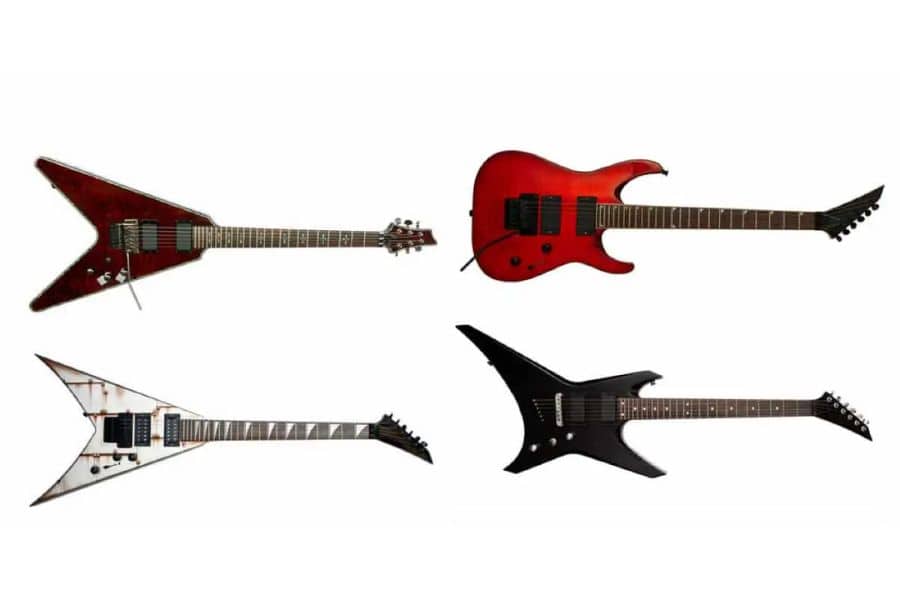
The guitar itself doesn’t change the type of music played more than any other part of the signal chain. However, getting the right guitar is the first thing you need to do when setting up your gear to get that metal sound. Most metal fans prefer solid body guitars because they’re sturdy and can handle high gain without feedback.
Pickups on your guitar are also important. For a heavier, fuller sound, humbucker pickups are your best bet. This is because they smooth out noise and interference, giving you that thick distortion metal sound.
Let’s talk about cabinets and amps now. If you’re still not sure whether to get a tube or solid-state amp, here’s the deal: tube amps are praised for their natural distortion and wide dynamic range, which makes them a favorite among purists. When it comes to metal, solid-state amps have the tighter sound that is needed for clear clarity.
The speaker cabinets you choose are just as important for making those metal riffs sound powerful and clear. The way your speakers are set up (for example, 4×12″ for a full, strong sound) can have a big impact on how present and punchy your guitar sound is on stage or in the studio.
Make An Electric Guitar Sound Metal Through Amplifier Setting
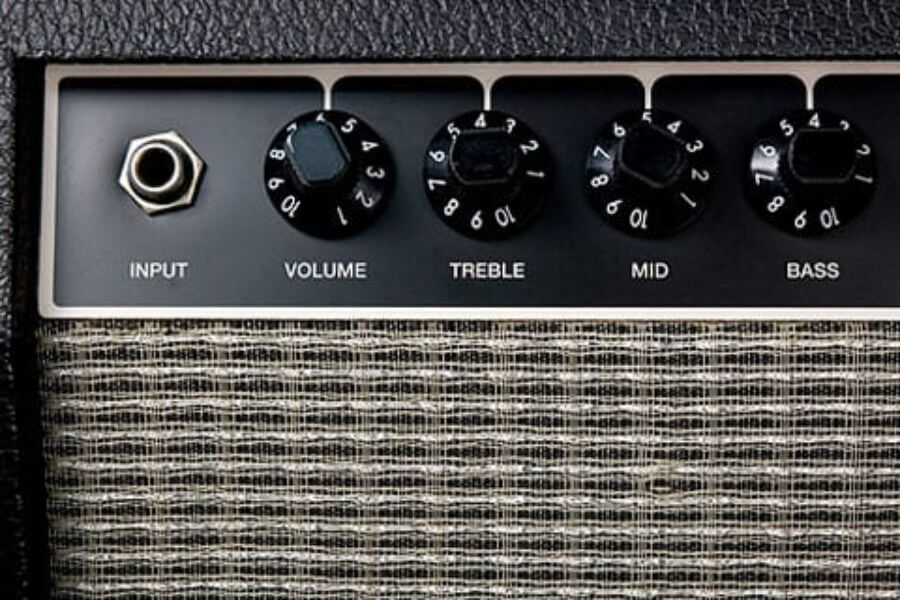
The settings on your amplifier are very important for getting that deep, distorted metal sound you love. You need to know how to use Gain and Overdrive. When you set the gain correctly, riffs and leads sound thick and clear. Too little gain, the sound will be weak, and too much makes your sound unclear.
The bass, mid, and treble EQ levels are all very important. These knobs let you shift how your guitar sounds. Bass can add strength to beat parts and make them sound stronger. Scooping the mids makes the tone more aggressive, while raising them makes the sound broader. You can use the treble control to make your leads and breaks stand out.
Another factor, Presence and Resonance finish off your tone palette. Higher-frequency notes sound more alive when you add Presence to your guitar. Lower notes get louder because of Resonance.
Creating Metal Sound with Effects and Pedals
Most of the time, getting a metal tone is easy—all you need is high gain, distorted guitar sounds, and certain EQ settings, like scooped mids.
The premise is simple, but achieving a solid metal tone takes a detailed understanding of how gain impacts clarity, how EQ settings form band mixes, and how guitars and amps react to alterations.
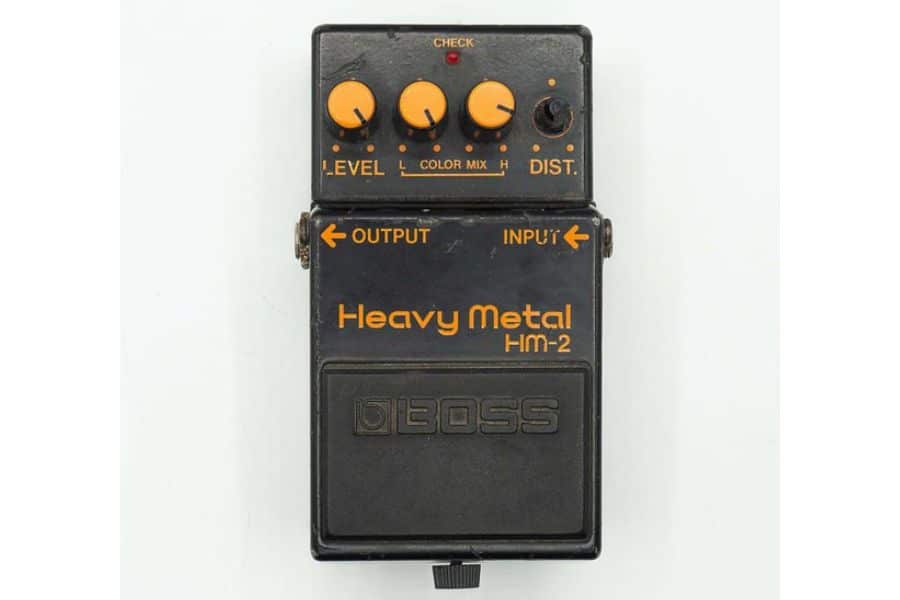
Distortion and Overdrive Pedals
Distortion and overdrive pedals give you the aggressive and heavy sound characteristic of metal music. Consider pedals that you can adjust for different metal subgenres, from classic heavy metal to death metal and everything in between.
To get these pedals set up, tune in mild distortion and make any necessary changes to your distortion or overdrive pedal. Match the output level to the signal that is being bypassed for the least amount of noise changes.
Set the Gain to about 70% of its highest level, the Treble to 60% to 80%, the Middle to 40%, and the Bass to the same 60% to 70%. It will sound like classic rounded metal.
To get the natural sound of both your guitar and amp, use the EQ on the pedal to boost the mids for leads and lower them for rhythm parts.
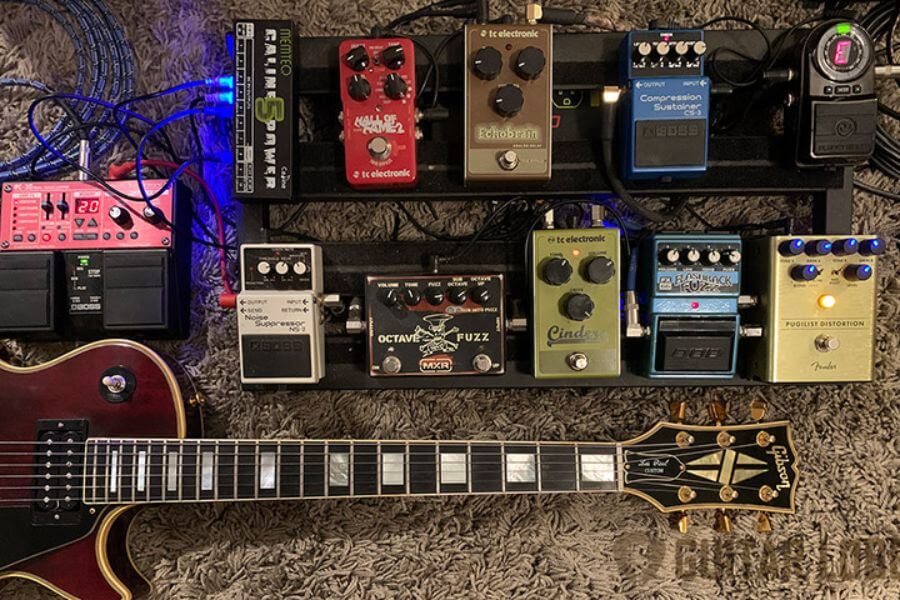
Some recommended pedals
You might not be getting the best overdrive from the amp, so instead, check out some distortion pedals at a guitar shop:
- Boss Metal Zone MT-2: The MT-2 is a staple for metal guitarists with its deep tone shaping capabilities and dual-gain circuitry.
- Electro-Harmonix Metal Muff: There is a wide range of distortion sounds, from slight overdrive to extreme metal distortion that this versatile pedal can provide.
- MXR M116 Fullbore Metal: It offers high gain, a built-in noise gate, and a 3-band EQ to shape precise tone for metal players.
Delay and Reverb
In metal, these delay and reverb pedals add dimension and space to your guitar tone and are often used subtly to avoid muddying the aggressive tone.
Set a short delay time with a few repeats to thicken your sound or longer delays for solos to add some space.
- When You Play Rhythm: Turn the delay to 20-30 milliseconds with 1 or 2 repeats. It makes your guitar sound fuller but still clean.
- When You Play Leads: Use 300-600 milliseconds delay with 3-5 repeats. It makes your solos echo nicely. Make sure it’s not too loud.
To add depth to your tone without overwhelming the distortion, make a slight amount of reverb by using the plate or hall reverb setting.
- Plate Reverb is great for a shiny sound. Use a 1-2 second echo for solos, and less for rhythm. It keeps your sound crisp.
- Hall Reverb gives you a big-room sound. Use a short 1.5 second echo. Keep it low so it doesn’t get messy.
Delay and reverb pedals can amplify not just the intended guitar signal but also any background noise, hum, or hiss present in the signal chain. High-gain settings can even increase these noise and signals.
To deal with this, a noise gate pedal can manage unwanted noise and feedback from high-gain distortion. Set the threshold just high enough to cut the noise when you’re not playing but low enough not to affect sustain or cut off notes prematurely.
EQ Pedals
You can make big changes to your sound with an EQ pedal. Boosting frequencies can make your guitar stand out more in the mix. For metal, boosting the low-mids can make the riffs chunkier. Plus, it can cut frequencies. For example, a small cut in the low frequencies can keep the sound from getting too boomy.
The best metal guitar tone can only be made with the right tools and setup. You have to try different settings until you find the ones that work best for your guitar, amp, and playing style.
Using Amplifier Knobs vs Using Pedals: Which Is Better?
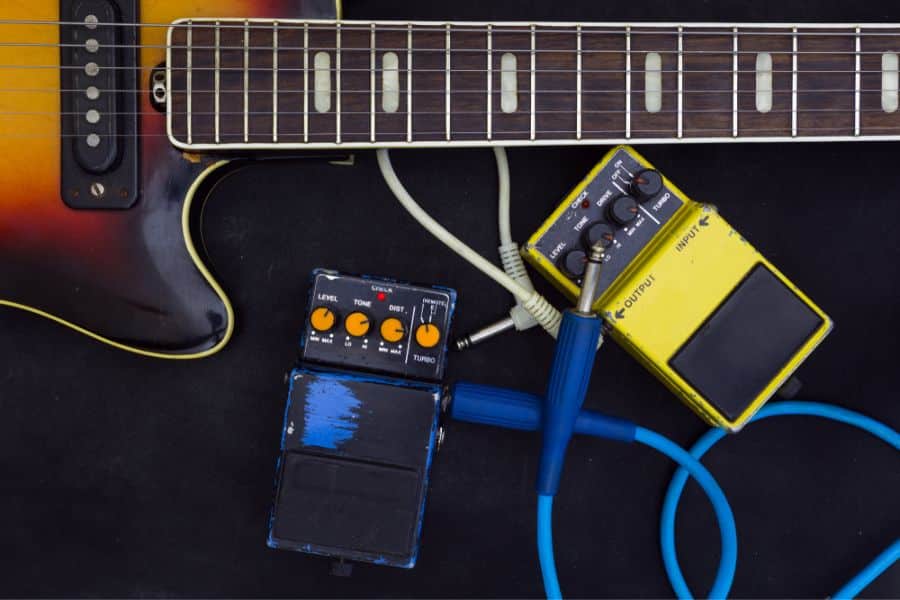
It’s kind of like using amplifier knobs on an electric guitar, but pedals change the sound of your guitar in different ways and give you more options.
Gain, volume, and a basic EQ section (bass, mid, and treble) are all normal amp settings. Pedals can do these things more precisely or give you more choices.
A pedal can change the sound with delay, reverb, chorus, phaser, distortion, and EQ, but an amp only lets you control the volume and tone.
Pedals can also adjust signal chains better. Putting effects in a certain order can make sounds that an amplifier can’t do by itself. You can quickly switch, change, or add more pedals to your signal chain to try out various sounds, tones, and sets for various styles and songs.
Playing Techniques Suitable To Metal Sound
Early on, I put too much emphasis on my gear, overlooking the fact that how I played was just as crucial. Let’s talk about some of these important metal playing tips.

Power Chords and Palm Muting
On a metal rhythm guitar, the first chords are power chords. When played on the lower strings, these simple chords make a strong sound that describes heavy riffing in this style.
When you play power chords and palm mute (lightly putting your picking hand against the strings near the bridge), you get a tight, aggressive sound.
When you palm mute, you give each note or chord a heavy, percussion-like sound that fits with metal’s fast beats and chugging patterns.
More advanced methods
As you get better at the basics, you can move on to more difficult techniques.
Tapping
When you play with both hands on the fretboard, you can play fast, difficult melodies and arpeggios that you can’t do with a pick. Tapping is used for fluidity and legato in shredding leads.
Sweep Picking
Neoclassical metal players often use sweep picking to play arpeggios quickly, making the playing sound like a violin. When you play arpeggios quickly, “sweep” the pick across several strings in one stroke and make sure your plucking hand moves at the same time. It takes you lots of practice and precision to play this technical metal.
Pinch Harmonics
You can make a high-pitched harmonic sound with pinch harmonics, which are also called squealies, by lightly touching the string with your thumb after playing it. This method highlights and embellishes notes, which makes solos more evocative.
How to Write a Metal Music Riff
Try to write lines that are both hard to forget yet complex at the same time. Metal riffs use minor scales, shorter intervals, and chromatic parts to make them sound scary and dark. The song “Raining Blood” by Slayer uses chromatic movements and minor scales to create a scary mood that is typical of thrash metal.
These tips will help you play and write better music, and they will also help you enjoy the wide range of sounds that metal has to offer.
Master Metal Technique By Practicing And Inspiration
The best way to get good at playing the metal guitar sound is to practice hard and listen to a lot of metal songs.
The Importance of Practice
Practice regularly and with focus if you want to get better at playing difficult riffs and solos. In practice, both quality and quantity are important. You should set clear goals in every practice terms, from mastering a skill, speed, or accuracy. Every famous metal guitarist started at the very beginning and got better by practicing all the time.
Looking for Inspiration
The legends of metal are the best source of creative inspiration. Immersing yourself in the discographies of famous metal bands and guitarists can open your ears to a vast spectrum of styles, techniques, and tonalities.
Learn about Black Sabbath, Metallica, and Megadeth, the genre’s pioneers. Focus on progressive metal and modern virtuosos like Dream Theater and Tosin Abasi.
By doing this, you can understand how they create tones, riffs, and emotions via their playing can teach more than just copying.
Conclusion
The technical parts of making a metal sound are important, but they’re only one part of a bigger story. Metal music’s true core is its power to make you feel something, to say something deep and basic.
For guitarists, finding the right metal tone isn’t just about getting better at the instrument; it’s also about finding our emotional voice in the music. It’s a mix between understanding the basics and feeling what it’s all about. It is this that gives the metal sound its unbreakable spirit and lasting attraction.









